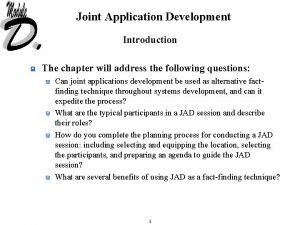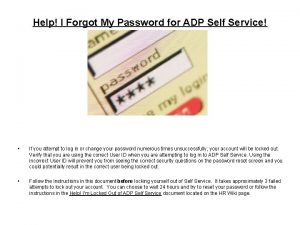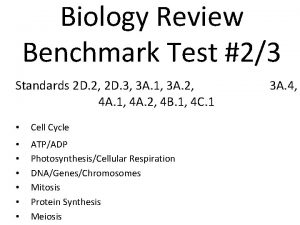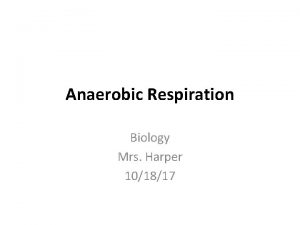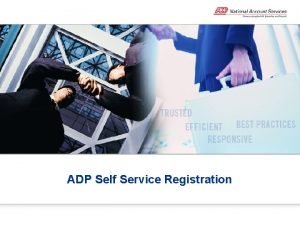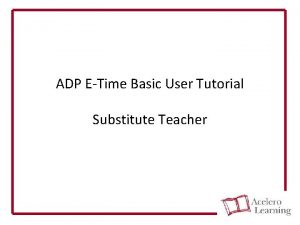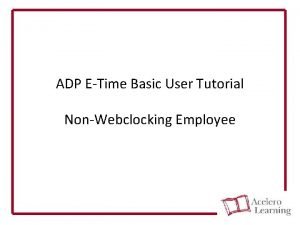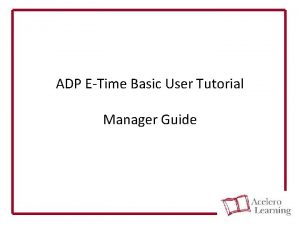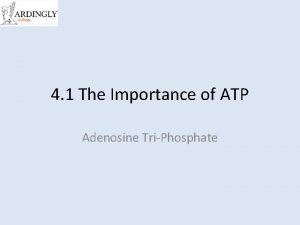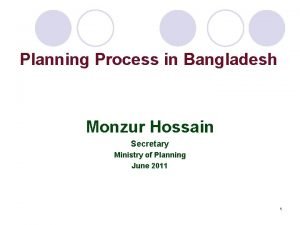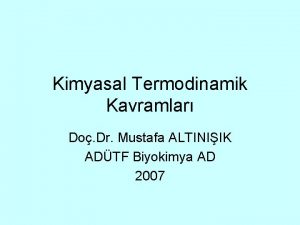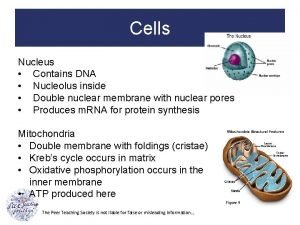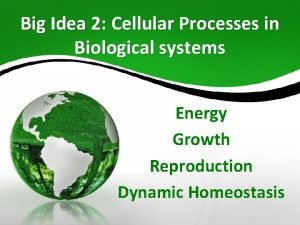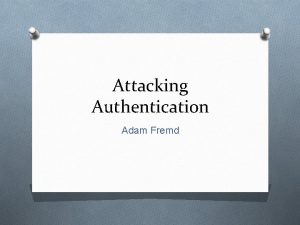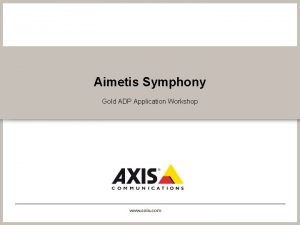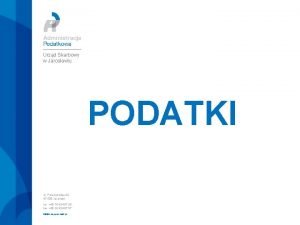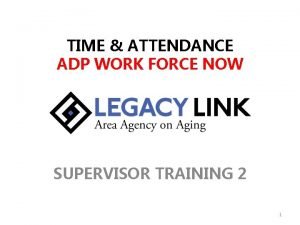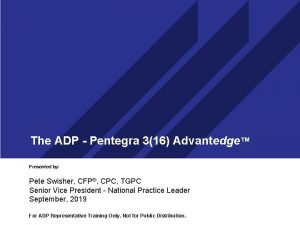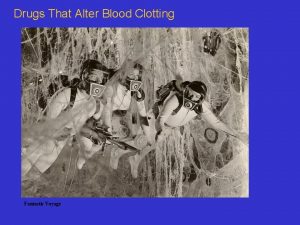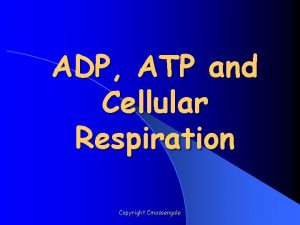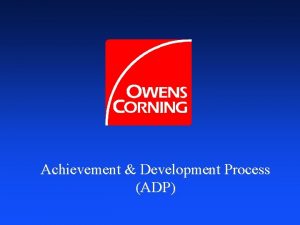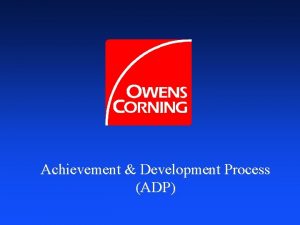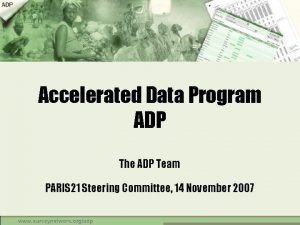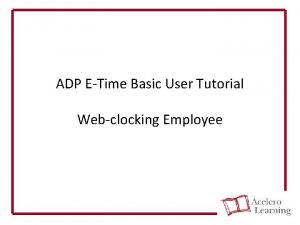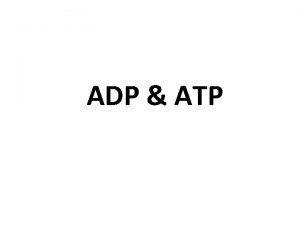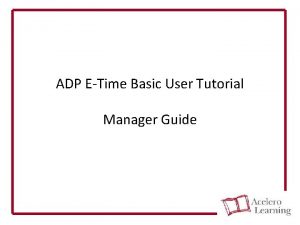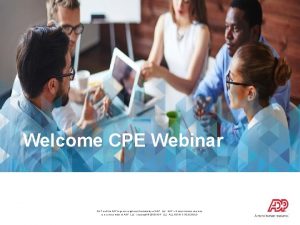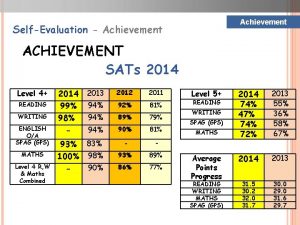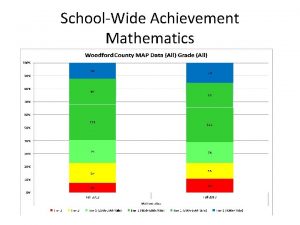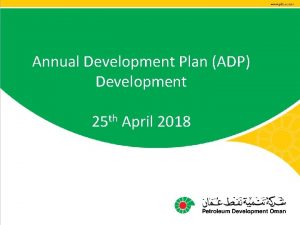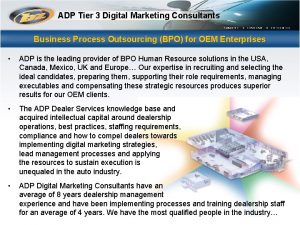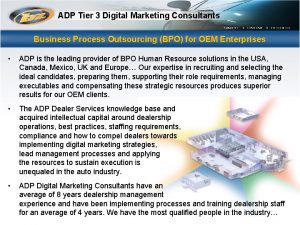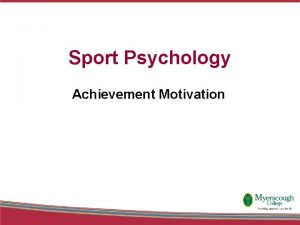Achievement Development Process ADP Outcomes of Session n



































- Slides: 35

Achievement & Development Process (ADP)

Outcomes of Session n Understand your role in a Performance Management Process n Understand the four elements of the Achievement and Development Process - Goal Alignment - Continuous Feedback - Summary Discussion - Human Resource Review

Why have a Performance Management Process? n Clear Expectations of the Individual n Aligned Goals n Clear Performance Understanding n Career Development Plan n Plan for Individual Improvement in the position n Evaluate Corporate Resources (individuals) n Individual Income Management n Manage individual Expectations n Open two-way Communication

Performance Management Components Achievement & Development Process Training & Development Balanced Measures Performance Management Compensation Strategy Career Development Staffing Strategy

ADP Process by which we can: n Set individual performance goals n Review performance against goals n Plan future goals n Determine equitable compensation n Support individual development n Aid individuals in career planning

Elements of ADP Achievement and Development Process Goal Alignment Continuous Feedback SUCCESS Summary Discussion Human Resource Review

Goal n A desired result that increases customer satisfaction and/or improves processes to attain business objectives; n A desired result that contributes to employee growth and development

What is Goal Alignment? n Process used at all levels of the organization for setting goals that are consistent with and supportive of with the goals of: – the next level up and down - Vertical – key customers - External – key partners within the company - Horizontal

Goals/COTs - Definition Business Goals: macro, high level, business results/objectives; there can also be higher level business unit/process area goals Individual Goals: Your business unit/process area objectives that support the Business Goals. Critical Operating Tasks: specific actions key to the achievement or in support of corporate or business/process area goals

ADP Goals/COTs drive. . . n Individual / team accountability for achievement of results – performance n “pay for performance” compensation through merit increases and incentive pay

Effective Goal/COT Development Checklist 1. Specific. . . describes end results 2. Meaningful. . . contribute to accomplishment of business goals 3. Aligned with other goals. . . linked with higher level goals & goals across organization/between functions 4. Realistic and attainable. . . a manageable number within your control 5. Timing and measurable. . include a deadline 6. Balanced. . . include process improvement & end result achievement; team and individual results

Elements of ADP Achievement and Development Process Goal Alignment Continuous Feedback Summary Discussion Human Resource Review

Continuous Feedback Process Evaluate Progress Identify feedback sources Solicit feedback Develop and Implement Action Plan Prepare & Lead ADP summary discussion with leader Document & interpret feedback

Possible Feedback Sources n Your feedback sources should include: – yourself – your leader – peers & colleagues – team members – cross-process team members – internal and external customers/suppliers Identify feedback sources

Good Feedback Document & interpret feedback n Is informal and ongoing n Relies on combination of sources and methods used to collect it n Comes from asking open questions n Depends on active listening n Is specific, based on examples, and actionable n Develops over time n Usable for improvement

Competencies Solicit feedback n Categories of behaviors key to roles performed at OC n Typically used during interview process n Examples: – communication – teamwork – problem solving – customer focus n Use these in soliciting feedback and to outline strengths & areas for development

Elements of ADP Achievement and Development Process Goal Alignment Continuous Feedback Summary Discussion Human Resource Review

What is a Summary Discussion? n Leader and employee have a discussion on the following: – performance against goals – summary of feedback collected, how those learnings were applied – strength/development area identification – career growth (short and long term) – development needs and plan n Formal documentation once per year (based on reviews during the year)

Characteristics n Each business determines the timeframe n Leader and employee both prepare and discuss n Leader acts as coach n Focuses on achievements and development n Forward looking – new goals/COTs for the year – development needs & career objectives n Leader and employee share feedback

Preparation n Summarize – overall performance & achievements against goals/COTs – feedback received n Identify: – strengths & developmental areas – Tie to Competencies – career planning (short & longer term) – development needs/actions – possible new goals/COTs n Use common electronic format for summary discussion

Goal/COT Alignment

Competencies n Supporting Tools: – Leadership Characteristics • 10 Characteristics that have been identified by the Sr. Leadership Team – Job Competencies • Also known as Targeted Selection interview dimensions n Competencies by Function – Provides selected Characteristics and Competencies that should be reviewed for employees in specific functions.

Position Description The ASM is responsible for development and implementation of a territory business plan defining distribution, product, pricing and promotional strategies (including System Thinking concepts and processes) for designated retailers and distributors of Owens Corning building material and composite products. This position drives the generation of sales growth for the Roofing, Insulation, Composites and Exterior Systems Business Units within the assigned area which may have approximately $8 -$10 million in annual sales volume. Strategies include account conversions, product upgrades, new product introductions and effective use of internal and external sales support resources to build customer partnerships. The ASM works with product and sales teams including a customer service support team for the region. The ASM manages local pricing to build profitable businesses across multiple product lines. Building customer relationships is key to delivering outcomes, along with working through a variety of markets and channels of distribution. The product mix includes glass, insulation, roofing, foam, siding, and windows. The markets and channels of distribution include one and two step distributors; buying co-ops, retail store chains, and national accounts. Performance requirements include achievement of sales commitments by business unit; emphasis on profitable product mix; focus on the customer’s customer; and management of expenses within a budget. Key competencies include tenacity, problem solving, risk taking persuasiveness, responsiveness, independence, customer focus, work standards, teamwork, and communication skills.

Leadership Characteristics n Catalyst for Change n Personal Confidence n Good Listener n Personal Integrity n Communicates Openly and Seeks Information n Encourages Individual Dignity n Creates Teamwork Climate n Seeks Personal Growth n Sense of Urgency n Sense of Humor

Competencies

Leader’s Role n Initiates process and schedules final review n Preparing for discussion as employee does n Responsible for seeing that all elements are covered n Provide own feedback n Reality check on performance results, strengths/development areas, career objectives & development plans n Coach employee n Ensure Summary Discussion Form is documented and signed

The Bands Officers Senior Leadership Managers, Senior Individual Contributors Supervisors, Professional, Analysts Technical Administrative 8 $15, 000 to $55, 000 7 $20, 000 to $70, 000 5 6 $30, 000 to $100, 000 $50, 000 to $140, 000 Leadership 4 $65, 000 to $175, 000 3 $90, 000 to $300, 000 2 $120, 000 to $520, 000

How does my evaluation affect my pay? n Performance evaluation is one tool that is used in determining an employee’s merit pay. – Focus on past year performance, multiple input from multiple levels – Overall achievement – Look at contributions to assignments; were improvements made or were processes done more efficiently

Determining Merit Pay n Focus on performance, achievements, feedback n Look at contributions to assignment n Consider current salary in relation to market value and band ranges of assignment n Consider amount and date of last increase n Administered within salary budget

Determining Incentive Pay n In addition to salary n Driven by business goals n Awarded against a predetermined plan – Parameters are set n Paid per individual and/or team performance against plan n May have a management discretion component n Can be eliminated at any time at the company discretion

Elements of ADP Achievement and Development Process Goal Alignment Continuous Feedback Summary Discussion Human Resource Review

What is an Human Resource Review (HRR)? n A process in which leaders of the company meet to discuss the status of the company’s human assets n Follows Achievement and Development Summary discussions n Among leaders of a particular organization (NLT’s) n Facilitated by Human Resources Representative

HRR Focus n Human resource implications of business strategy n Potential organizational structure changes n Needs of selected employees n Potential job movements n Training & development needs n Succession planning n Diversity opportunities n Inventory of organizational skills n Recruiting needs

HRR Outputs n Plans for job movements, succession planning, recruiting n Development needs n Feedback to Training and Development organizations n Shortfalls in structure, skills, training, and manpower

 Advantages of joint application development
Advantages of joint application development Adp password reset
Adp password reset Meiosis 1
Meiosis 1 Difference between atp and adp
Difference between atp and adp Adp self service login
Adp self service login Adp ez labor management
Adp ez labor management Adp e time
Adp e time Adp tutorial
Adp tutorial Accenture adp
Accenture adp Role of atp
Role of atp Adp.plancomm
Adp.plancomm Fosforilasyon çeşitleri
Fosforilasyon çeşitleri Atp adp dönüşümü
Atp adp dönüşümü Adp prétragienne
Adp prétragienne Adp pretragienne
Adp pretragienne My adp account is locked
My adp account is locked Is the nucleolus inside the nucleus
Is the nucleolus inside the nucleus Eetd adp
Eetd adp Adp pearltrees
Adp pearltrees Wotc.adp
Wotc.adp Atp and adp cycle
Atp and adp cycle Atp and adp cycle
Atp and adp cycle Adp secure client login pearltrees
Adp secure client login pearltrees Azitromisin
Azitromisin Axis adp
Axis adp Managed siem adelaide
Managed siem adelaide Steve murawski
Steve murawski Eurzd skarbowy
Eurzd skarbowy Adp time and attendance tutorial
Adp time and attendance tutorial Pentegra withdrawal
Pentegra withdrawal What does adp stand for
What does adp stand for Xarelta
Xarelta Organogram of adp
Organogram of adp What is adp made of
What is adp made of Adp sous digastrique
Adp sous digastrique Adp antagonist drugs
Adp antagonist drugs
